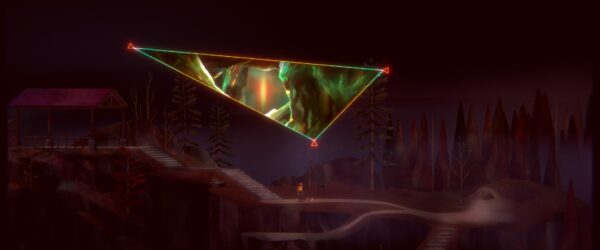You know how I just talking about developers I hadn’t kept tabs on? Well looks like it’s happened yet again as whilst having a look at how long it’d been since I played Oxenfree, the seminal title from Night School Studio, I noticed it’d been a healthy 7 years since it’s release. Wondering if they’d been up to anything since then, given that long is a bit of a stretch for an indie studio, I found that yes indeed they’d released another title with their trademark style back in 2020. Whilst that particular title will likely sit on the backburner for a while the release of the sequel definitely caught my eye. It does a great job of capturing the essence of the original and giving some closure to the overall narrative that the original setup.

Riley has returned home to Camena Coast after being away for many years. It’s mostly for the job, at least that’s what she tells herself, helping out a team of scientists investigate some strange radio anomalies that have been detected along the coast. She meets up with her coworker, Jacob, a fellow local who begins to reminisce about the times they shared together all those years ago. Things take a turn for the paranormal after they erect the first radio transmitter, creating a resonance cascade that opens up a portal above the nearby Edwards Island. This begins her journey to find out why this is happening and, in the process, work through her own trauma which both pushed her away from and brought her back home.
Oxenfree II retains the same visual stylings of its predecessor with the same pre-rendered backgrounds layered with 3D models that pay homage to adventure games of yore. Their style has been heavily refined and uplifted as well with bigger environments, lots more detail and liberal applications of modern lighting effects to uplift the whole visual experience. The game is at its best when you’re a small figure in a big open landscape as some of the sheen starts to come off when you get up close and personal with the little 3D figurines which aren’t exactly detailed enough to be convincing. Still though I like the 80s aesthetic they were going for which definitely had some Stranger Things vibes going for it (even though they came long before the series did).

The core of the game hasn’t changed much, still retaining the core choose your own adventure/point and click mechanics that the original did. You’ll still be freewheeling through a radio to unlock puzzles, resonate with certain objects and listening to radio stations to get clues. You’ll also have access to a radio now, which lets you communicate with a bunch of individuals directly, something which is needed for certain narrative paths and puzzles. Putting this all together means you’ve got a game that’s a bit more well paced than its predecessor as it’s a bit more interactive overall. This also bodes well for replayability, although that’s not something I have explored.
The puzzles are pretty straightforward for the most part, usually being wholly self-contained on the page that you find them on. Just like its predecessor though there are a non-zero number of them which will require you to wheel through the radio frequencies to find the right one in order to get things moving. This is only made ever more tedious by the introduction of the improved radio which doubles the frequencies and, thus, the space in which you need to search. Whilst this wasn’t a major issue for the most part some of the later puzzles which don’t give any hints about the frequency you need to tune to are can be an exercise in frustration. I will admit this will partly be my fault for unlocking my mouse wheel and trying to freewheel through everything quickly (something the game has protections against) but even going slowly meant spending a good few minutes simply scrolling to find it.

After the game’s opening moments you’re presented with what looks like a few options to progress the story. In reality that’s not so much the case, as I opted to head for one section which is completely unavailable to you until you unlock the advanced radio much later in the game. I’m not sure if the other sections have any gates on them like that (none immediately jump to mind) but it’s clear that the game has a preferred path that it’d like you to tread. This isn’t necessarily a bad thing, although giving players the illusion of choice when it in fact has no impact at all always feels like a dark pattern that shouldn’t be repeated.
Which is an interesting thing to note given that the game does hand over a lot more control than it did previously with your influence over events. To be sure, you can’t escape the core narrative that the developers have setup for you, but the nuance of how things play out in certain situations is definitely under your control. This was a criticism I saw levelled at the original a couple times, the whole showing narrative control whilst giving none, but this time around I think they actually do accomplish that to a certain degree.

The narrative itself also feels a bit more compelling than it did the last time around as well. Whilst they do advertise Oxenfree II as not requiring playing the original to appreciate it I certainly feel like you’d be missing out on a lot if you didn’t (and for those who did and, like me, can’t remember shit about it may I recommend this video). That being said the core story around Riley, her trauma, and how she’s looking to deal with it is solid within its own right, it’s just that the payoff of both of them feels much greater than if it’s experienced just on its own.
A minor nitpick I will level at the game though is the whole “conversation will continue” prompt that shows up when you’re switching between levels. It’s true most of the time although there were quite a few times when I switched scenes only to either have the dialogue end or have it get restarted from the beginning again. Most of the time the ones getting interrupted were optional conversations, or ones I could trigger again, but there were a few that didn’t seem to cross over seamlessly. Honestly I just ended up waiting most of the time for the main parts to finish, just so I didn’t miss out on anything.

Oxenfree II: Lost Signals is everything that a sequel can hope to be. It retains the essence of the original whilst also iterating and improving on the formula. The trademark visual style remains, along with the same core gameplay loop that proved an effective canvas on which to paint the narrative. The story itself was also compelling, avoiding many of the mistakes that sequels like this can fall prey to, like loudly hinting towards a sequel. There’s a couple minor issues, but only one that really bears mentioning. Oxenfree II ticks all the boxes I expected it to and I now have another developer that I really should remember to check in on more often.
Rating: 8.5/10
Oxenfree II: Lost Signals is available on PC, PlayStation 4, PlayStation 5, Android and iOS right now for $30.00. Game was played on the PC with a total of 5.1 hours playtime and 25% of the achievements unlocked.



